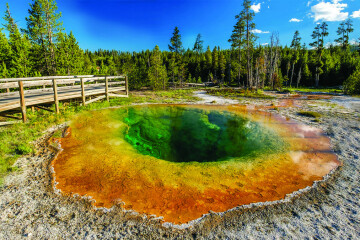Top 10 Sights to See in Yellowstone
With awe-inspiring geologic features and humbling natural phenomena, Yellowstone National Park stands out as one of the country’s greatest swaths of preserved wilderness. Whether visiting to learn about its impressive geothermal systems, spot some of its diverse wildlife or simply take in its postcard views, this national treasure offers anyone a deeply meaningful outdoor experience. But, before jumping into a breathtaking road trip, take a look at these ten features worth witnessing to optimize your Yellowstone itinerary.
Mammoth Hot Springs
Presenting scenes almost exactly out of an obscure 1980s sci-fi novel, Mammoth Hot Springs greets visitors with uncanny views of approximately fifty travertine formations. Pale limestone and terraced basins—all filled to the brim with multicolored, acidic water—allow guests to marvel at the raised bowls of soft stone, and appreciate unique, geologic features through either an upper or lower boardwalk. Surprisingly, algae and microbes can be observed thriving on the limestone, coloring the stark white deposits in various hues of orange and brown.
Tower Fall
What better to contemplate Yellowstone’s inspiring beauty than the soft, misted spray of water crashing into a 132-foot freefall? Featuring impressive views of surrounding rock pillars and a nearby overlook to gaze at Tower Creek as it makes its plunge, Tower Fall gives onlookers the opportunity to experience the raw, churning power of nature up close. Gazing downstream, the turbulent creek can be seen joining with the Yellowstone River, eventually flowing northward and out of the park.
Artist’s Paint Pots
Within the Gibbon Geyser Basin, a boardwalk path just over a half of a mile—the Artist’s Paint Pots Trailhead—leads visitors among impressive collections of active springs, geysers, and mud pot thermal features. Varied levels of iron oxidation within the acidic slurries result in a wide variety of dynamic colors: While some simmering mud pots exhibit a milky-blue hue, others take on a pleasant brown or grey color. Any travelers will be sure to savor the boiling pools and rust-red deposits of sulfur that often surround them, knowing that a brief hike can be rewarded with resplendent views of the Artist’s Paint Pots’ surreal and rugged landscape.
Grand Prismatic Spring
When visiting Yellowstone National Park, laying your eyes onto Grand Prismatic Spring, the largest hot spring in the United States—and third largest on the entire planet—is simply a must. Spanning approximately 370 feet wide, and reaching depths up to 160 feet, the steaming water is called home by an abundance of thermophiles: heat-tolerant microbes that form vibrantly colored communities, or “mats” within the blistering water. Be sure to witness its striking pigments throughout the year if you can, as microorganisms in the boiling lake tend to produce red and orange pigmentations in the summer, and dark green tones during the winter.
Sulphur Cauldron
You would certainly not expect to stumble upon a violent, frothing pit of 190°F, sulfurous water during a casual excursion into the wilderness, especially a pit with a pH equivalent to battery acid. However, should you travel north on Yellowstone’s Park Loop Road, you can certainly enjoy the sublime scenery afforded by Sulphur Cauldron—one of the park’s most acidic hot springs—its vivid, frothing water and pungent aroma quickly justify the thermal feature’s unsavory moniker. With Mud Volcano and Dragon’s Mouth Spring providing additional sites to explore nearby, this destination is one that is sure to keep you fascinated and amazed at your surroundings.
Old Faithful Geyser
Undoubtedly one of Yellowstone National Park’s most famous attractions, this thermal feature inspires spectators with its profound beauty, and fills those who view it with an incredible appreciation of the natural world. Shooting upwards of 130 feet on average, the geyser not only spews up to 8,400 gallons of water into the air in as long as four-and-a-half minutes, but does so predictably enough to be forecasted within ten minutes at a 90% confidence interval. If you do end up visiting this incredible site, be sure to remain on the surrounding boardwalk! Walking off of designated pathways around the geyser can damage its fragile crust, and superheated steam erupting from Old Faithful can reach lethal temperatures upwards of 250°F.
Old Faithful Inn
Towering above its surroundings and claiming the title as the largest log structure in the world, Old Faithful Inn serves as a seven-story complement to the idyllic, exaggerated landscape that surrounds it. Built between 1903 and 1904, the alpine lodge features an impressive 76-foot-tall lobby, hardly containing an even grander fireplace: a construction of white, volcanic stone climbing 85 feet into the air. Still operating as a lodge today, the inn is open from early May to early October and accepts reservations a year in advance—encouraging guests to book rooms early.
Yellowstone’s Petrified Tree
Fossilized and perfectly preserved by ancient volcanic eruptions and mudflows, Yellowstone’s Petrified Tree showcases just how different the park’s local climate was tens of millions of years ago. The fossil stands resolutely in a small, fenced enclosure off of Grand Loop Road, a timeless memorial to long-extinct redwood forests that flourished in the area, and provides an ancient glimpse into Yellowstone’s past ecosystem. A snapshot in time, the tree not only informs visitors about long-gone fauna that previously flourished, but also provides utterly mind-bending perspectives on the timescale of geologic events, and life itself.
Yellowstone Falls
The Upper and Lower Yellowstone Falls crash and cascade through the Grand Canyon of the Yellowstone, forming two major watercourses that funnel up to 8,400 cu ft/s of water down an intimidating 109 and 309 foot drop, respectively. The mighty outpour of the Yellowstone River is certainly a noticeable descent as well: Park guests observing thunderous claps of tumultuous water from overlooks afforded by the Brink of the Lower Falls Trailhead witness a drop twice as high as Niagara Falls! Its deafening crashes and steep precipices instill humbling senses of grandeur onto those who gaze out to the falls, and their explosive power helps distinguish them as one of the park’s most impressive locations.
Roaring Mountain
North of Yellowstone’s Norris Geyser Basin, the hills of Roaring Mountain whistle and whine from torrents of steam and gas escaping through fumaroles—cracks in the Earth’s crust—that perforate the mountain’s western slope. Magma flowing close to the surface heats up groundwater that evaporates and shoots into the air through a crust of volcanic rhyolite—hissing and rumbling as it shoots from the ground. The surreal displays from this thermal feature definitively place Roaring Mountain as a fascinating, must-see destination within the park, stunning spectators with thick plumes of rumbling steam and hissing gases that steadily rise up from its slopes.
Yellowstone National Park has no shortage of incredible and unique environments worth seeing: its natural wonders help provide us with fond memories to cherish, further educate us about natural processes, and even inspire us to continue protecting the outdoors as a valuable resource for future generations. The opportunities we have to visit and enjoy public lands are something valuable, and definitely worth taking advantage of, but it’s up to you to experience them for yourself. Visit the National Park Service at https://www.nps.gov/yell/planyourvisit/basicinfo.htm for information on entry fees, weather updates, directions and more!





